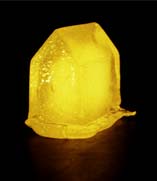
Untitled (Camera Obscura Curtain)
In this Camera Obscura an image from outside the window is projected onto a curtain, hanging about a foot inside the glass. However, instead of using a single hole, I am using multiple pinholes, creating a pattern of overlapping projections onto the fabric. The intention is to surprise the viewers when they discover that the pattern on the curtain is not a print, but are live projections. The images gets bigger and smaller when the curtain is moved, but what is most striking is when traffic passes outside the window and the motion brings it to life.
Large sheets of paper are used to block out the light in the room and the pinholes are created by cutting small x-marks into the paper. The signification of the x-marks, only visible when looking behind the curtain, is to mark the pinhole as a point rather than a random hole.
41 Summer St - A Camera Obscura
This Camera Obscura was installed a in a storefront window, next to a busy one-way street. Here I blocked out the light using old windows, mounted inside the permanent window, and painted in vivid colors. The painted windows was intended to brighten up "Summer street" in this industrial town.
The pinholes were created by scraping holes in the paint, and make apertures with a wide angle of perspective. The pinhole, functioning like the aperture in a camera, makes the sharpest image when the hole is as small as possible. However, there is a point when the hole would get too small and make the image too dark.
Inside of the windows I glued ball-shaped glass bubbles, which were sandblasted, to serve as "projection screens." The image projected inside the glass became three dimensional, instead of the flat projection of the conventional Camera Obscura.
The projection of the Camera Obscura depicts a "live" image, upside-down and reversed. This is similar to the way the world is projected onto our retinas, before the brain flips it back to the way we "see." While working with the phenomena of the Camera Obscura I wanted to visualize the "world" as it really looks to our eyes, before altered by the mind. The glass bubbles, which are reminiscent of the shape of the eyeball can be said to depict this "true image" we can never see, unless using special lenses.
The bubbles were fastened onto the window in a line that traced the flow of the traffic outside. As the sound of cars outside were passing by from left to right, inside the glass bubbles they drove upside down and "reverse direction."
The Object Stares Back - Camera Obscura
This Camera Obscura was made for the annual MFA Show in the RISD Museum. It was installed in a window on the second floor overlooking the the backyard, which at the time had construction in progress. Also here, I used glass bubbles as projection screens, although here I am filling the window. On sunny days one was able to view the "upside down and reversed" construction-workers climb the ladders out-side the window.
The bubbles fills the window in a circle, with a concentration of bubbles in the center, and mimics the patterns of cones in the human eye. Again, I am making a comment on the function of the eye as the primarily tool we use to perceive the world.



